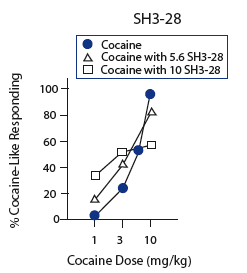 Co-administration of Rimcazole With Cocaine Blocks Locomotor Stimulation in Mice. When administered with cocaine, rimcazole blocked the stimulant effects of cocaine on locomotor activity.
Co-administration of Rimcazole With Cocaine Blocks Locomotor Stimulation in Mice. When administered with cocaine, rimcazole blocked the stimulant effects of cocaine on locomotor activity.Investigators in NIDA's Intramural Research Program (IRP) have confirmed and extended previous findings that rimcazole, a medication developed in the 1980s to treat schizophrenia, weakens some of cocaine's effects in rodents. The new findings strengthen speculation that drugs like rimcazole might help recovering individuals avoid temptations to relapse to cocaine. Rimcazole and related compounds share a novel mechanism of action, a sigma receptor blockade, that appears to have significant potential for loosening cocaine's hold on addicted individuals.
Drs. Jonathan Katz and Amy Newman and IRP colleagues showed that pretreating mice with rimcazole reduced one of cocaine's signature effects on rodent behavior: increases in locomotor activity—more running around. The impact on movement varied with the dosages of rimcazole and cocaine: At the maximum, a 73 ?mol/kg dose of rimcazole reduced by 57% the amount of locomotor activity rats exhibited following administration of cocaine (40 mg/kg). Other rimcazole-like compounds reduced locomotor activity following cocaine exposure by up to 47%, also depending on dosages.
 Pretreatment With Rimcazole Analog SH3-28 Decreases Subjective Effects of Cocaine in Rats. In rats conditioned to press a lever in response to cocaine injection, SH3-28 pretreatment reduced the accuracy of the animals' responses to cocaine.
Pretreatment With Rimcazole Analog SH3-28 Decreases Subjective Effects of Cocaine in Rats. In rats conditioned to press a lever in response to cocaine injection, SH3-28 pretreatment reduced the accuracy of the animals' responses to cocaine.The demonstration that rimcazole attenuates locomotor stimulation by cocaine confirms previous similar findings by other researchers. The IRP team established for the first time an additional potentially important effect of rimcazole-like compounds: In rats, a closely related compound called SH3-28 weakens the subjective sensations that distinguish the cocaine experience. Rats pretreated with SH3-28 lost some of their ability to tell the difference between injections of cocaine and injections of saline—plain salt water.
In this experiment, the researchers first taught rats they could obtain food by choosing the correct lever between two options: To be rewarded, the animals needed to push one lever after receiving a cocaine injection and the other lever after receiving a saline injection. Once trained, rats pressed the cocaine-associated lever nearly 100% of the time after an injection of cocaine; however, when pretreated with 19 ?mol/kg of SH3-28 prior to receiving cocaine, they pushed the correct lever only about 60% of the time. Should these results carry over to people, rimcazole or a rimcazole-like medication might be used in treatment of cocaine abuse. Recovering individuals who abused cocaine while taking the medication would learn that the drug did not produce the desired stimulant sensations, reducing their motivation for future use.
"This area of research is still in the early stages of effectiveness testing, but if the present results prove reliable and can be extended to humans, it would appear that rimcazole and its analogs may have promise in further drug discovery efforts toward the treatment of cocaine abuse," says Dr. Frank Vocci, director of NIDA's Division of Pharmacotherapies and Medical Consequences of Drug Abuse.
The Mechanisms of Action
Rimcazole achieves its cocaine-suppressing effects at least in part by binding to and blocking the sigma receptor. This is a protein on the surface of some brain cells that receives chemical messages and relays them to the interior of the cells, stimulating or inhibiting some cellular activities. Compounds that block the sigma receptor inhibit cells from responding to dopamine, a chemical messenger that contributes to many of the addictive effects of cocaine as well as of other addictive drugs.
Rimcazole also binds to another protein on the cell surface, called the dopamine transporter. Most chemicals that attach here mimic the effects of cocaine, which itself is a potent dopamine transporter blocker. The IRP researchers are currently investigating whether rimcazole and rimcazole-like compounds produce an effect opposite to cocaine's because their sigma blockade overrides their dopamine transporter effect, or whether some more complicated interaction between the two comes into play. So far, the evidence seems to point to the latter possibility.
"Our findings suggest that the interaction of sigma receptor ligands and cocaine is complex and appreciably different from competitive antagonism—that is, rimcazole and its analogs do not appear to physically block cocaine from its binding site," says Dr. Katz. "It is possible that the effects of these compounds are due to the particular balance of dopamine transporter and sigma receptor actions they produce."
The IRP team's research constitutes the initial studies in a program of drug discovery. Future investigations will examine whether rimcazole and related compounds block other stimulant-induced effects of cocaine, attempt to isolate the exact nature of their effects at the sigma receptor and dopamine transporter, and—if the compounds continue to show promise—evaluate their safety and efficacy in animals and people.
Source
- Katz, J.L., et al. Behavioral effects of rimcazole analogues alone and in combination with cocaine. European Journal of Pharmacology 468(2):109-119, 2003. [Abstract]
